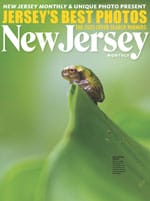




Halfway through a nine-course tasting menu at Elements, my friend looked up from a trio of thrillingly complex beef, tuna, and langoustine tartares with a sudden realization.
“We’re next door to a gas station,” he said.
It is hard to believe that a space this striking was until recently an auto-repair garage attached to that filling station. The chef’s tasting table faces a gargantuan open kitchen, once an auto-repair bay, and now gleaming with a double-sided flattop stove as big as a Hummer, slow-cooking CVap oven, and other state-of-the-art equipment that looks almost automotive in its complexity, plus a cooking and service staff big enough to conduct heart surgery. Elements, which opened in October of last year, is easily the best restaurant in America to replace a body shop and one of the best in New Jersey by any measure.
In the main dining room, the oil stains and air lifts of three former repair bays have been replaced by an aesthetic of muted earth tones accented with inlaid wood, brushed steel, glass, and the primal heft of irregularly stacked stone slabs on interior (and exterior) walls. Just past a stone-clad vestibule, under airy stairs leading to second-story seating and a glassed-in wine room, a softly lit, four-seat, stone-slab bar beckons. Under a ceiling two stories high, the cozy bar feels at once intimate and expansive—and from it come nuanced cocktails like the elder gin cooler, a refreshing blend of elderflower and cucumber-infused gin.
The restaurant is bankrolled by Stephen Distler—a semiretired private-equity executive turned Bank of Princeton chairman and restaurateur—and designed by architect Bob Steele with a price tag Distler won’t reveal. While Distler talks about instituting recession-friendly prix-fixe menus this year, he seems unfazed by the economy’s swoon. “I had a great run at some really good firms in the ’90s,” he explains. “I wanted to create something that would add to the landscape of Princeton. Profit maximization is not my goal.”
Executive chef Scott Anderson, an equity partner in the restaurant, may be Distler’s best investment yet. A Caldwell native and Rutgers graduate, Anderson, 34, has risen steadily since opening Nova Terra in New Brunswick in 2000. There’s no cooking school on his résumé, but he spent six on-and-off years at the Ryland Inn, where he rose to chef de cuisine before the restaurant closed. He was introduced to his business partner by Laurent Chapuis, owner of the Princeton Corkscrew Wine Shop, who told Distler that, if he wanted a serious kitchen, he had to talk to Anderson. Anderson invited Distler to swing by the Ryland for a tasting menu that showcased his talents (“extraordinary,” Distler says) and wines chosen by Emilia Sparatta, who is now Elements’ general manager and sommelier.
To appreciate Anderson’s imagination and work ethic, look no further than those three tartares. He mixed meltingly tender Kobe beef with whipped uni instead of the usual egg yolks for a salty, funky note, then placed an egg yolk—fried tempura style—on top, adding warmth and crunch. An accompanying salad of mizuna with Granny Smith apple and Asian pear countered the tartare’s richness with refreshing coolness and hints of bitter and sweet.
Tartare of Scottish langoustine, bracingly seasoned with toasted curry and shallots, overlay a swath of curry-infused honey. “Is that really a Tater Tot?” my friend asked, pointing to a crispy brown cylinder supporting a langoustine claw filled with tender meat. Yes, and it’s the best damn Tater Tot you’ll ever taste—punched from a classic potato galette and fried to a buttery golden brown.
The third tartare was made from Japanese Kindai bluefin—the first tuna successfully bred and raised in captivity. Kindai, which could provide a sustainable solution to overfishing, has an astonishingly clean, almost sweet flavor. Most of America’s tiny weekly allotment from Kinki University in Japan, where these show fish are bred, goes to restaurants like Per Se, French Laundry, Masa, and Le Bernardin.
When a representative from the university got word that a restaurant in New Jersey had obtained some Kindai, he was less than pleased. But he changed his tune after viewing photos on Elements’ blog (http://blog.elementsprinceton.com) showing Anderson expertly butchering the loin and fatty toro, and preparing a tartare with scallions, shallots, and a touch of white soy. Now Elements gets a weekly shipment, and at the time of this writing, the Kinki representative had dinner reservations.
Anderson also nails the basics, like cavatelli made in-house on a machine he scoured Italian eBay to find. He serves the cavatelli in a rich Bolognese sauce topped with a tender chunk of veal short rib and a dusting of truffle—the kind of rich, homey comfort food my Italian nonna makes (minus the truffles). And he champions underutilized, antiquated ingredients like cardoons, a relative of the artichoke, which he purées into a silky potato soup. The cardoons’ faintly earthy acidity perfectly complements a luscious treat at the bottom of the cup—an oyster rolled in shredded filo dough and fried to an almost nutty richness.
Much of Elements’ produce comes from the same county as the restaurant, but Anderson can get a little precious with it. A medley of fall vegetables—roasted, raw, and confit—was stuck in “soil” made of black barley and couscous “to replicate a local garden scene,” according to our server. The lofty description turned out to be the most enjoyable aspect of a bland, sexless dish. A better homage to local produce came in the form of a warm crépe stuffed with juicy, woodsy, wild and cultivated mushrooms and sharp Toma Primavera cheese from Cherry Grove Farm in Lawrenceville, and served with a subtly acidic celery- root truffle vinaigrette.
Elements’ short ribs were simply the best I have ever tasted. Cooked sous vide (under vacuum) in airtight plastic bags, they emerge from 48 hours in a circulating hot-water bath in a state of supernal tenderness and vivid flavor. Yet they were almost upstaged by the accompanying potatoes—local purple spuds cooked low and slow with duck fat and truffles until they, too, turned luxuriously tender. A Kobe ribeye steak, disarmingly rich and smooth, was sliced and spread around the plate with langoustine, Japanese turnips, matzutaki mushrooms, and a buttery purée of Long Island cheese pumpkin.
But Anderson’s painterly presentations and more-is-more sensibility can lack focus (and the sliced meats cool off too quickly). Chunks of sous-vide almond-crusted monkfish (much beloved in Spain) arrived lukewarm in a jumble of bit players—candied marcona almonds, more langoustine, and prized jamón ibérico, accented with almond purée and smoked paprika. The fish was delicious, but it could have done with half the accompaniments.
Despite $30 monkfish and $75 Kobe ribeye, you won’t need a second mortgage from Distler’s bank up the street to eat at Elements. Excellent skate with trumpet mushrooms and all-raw fall-vegetable slaw ($23) pairs well with an elegant, floral sparkling rosé from Spain ($34).
Sous-chef Joe Sparatta (husband of sommelier Emilia, and another Ryland alum) proves his mettle with a witty, yummy “pre-dessert” called bacon and eggs. The kitchen surgically removes the top and contents of an eggshell and fills it with a bit of brioche French toast, creamy egg-and-bacon custard, and maple-infused hot milk foam. A strip of bacon and a piece of French toast complete the presentation. Besides cleverly easing the transition from savory courses to sweet, this bacon and eggs would make a great eye-opener, something I’d happily eat every morning from now on.
For actual dessert, carrot cake infused with cardamom and topped with layers of ginger and cream-cheese ice cream sidestepped the usual pitfall of cloying frosting. Dense chocolate cake came with salted caramel, burnt meringue, and smoked maple-syrup ice cream. But the burning, smoking, and salting tasted overwrought. This was another case where I wished they had let the main event shine on its own.
But all was forgiven with a plate of petit fours, an ingenious array of candied, spiced macadamia nuts, micro Chipwiches, and apple and passion fruit gelées so concentrated in flavor that I divided into several tiny bites a square I might have gobbled whole while calculating the tip.
Most of the staff at Elements have followed Anderson there (“He’s like the pied piper,” Distler says), and while the servers can come off as eager acolytes, the service, if anything, was a little precious for a place where the owner hopes you’ll feel as comfortable in jeans as in finery. But if the staff’s everything-is-extraordinary attitude irks you, take a deep breath and remember that almost everything is.
Click here to read detailed reviews of more New Jersey restaurants.

